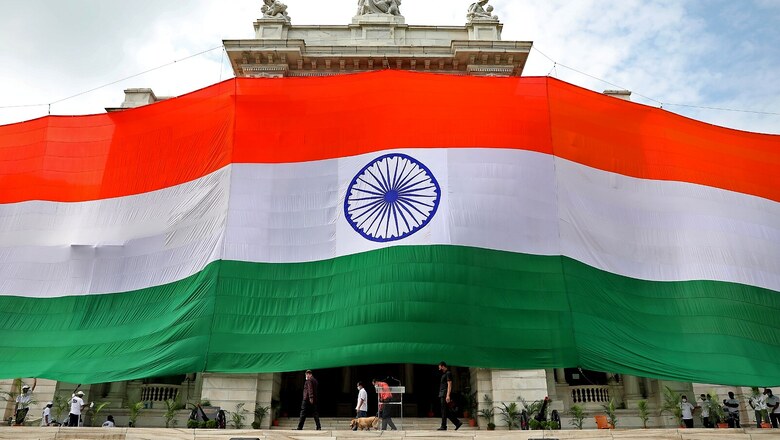
views
On June 3, 1947, when the British Parliament passed the Indian Independence Act, the British ensured that India will always be marred by “caste” and “minority” issues. In the 75th year of Independence, when India is advancing for the 5G revolution, our judicial system is confronted with a complex knot of Jurisprudence of Minorities.
Currently, six communities — Muslims, Christians, Sikhs, Buddhists, Parsis and Jains — are notified as minorities by the central government under Section 2 (c) of the NCM Act. Parliament and state legislatures have concurrent power to enact laws to protect and safeguard the interest of minorities. Accordingly, the State of Maharashtra has notified Jews as a minority community.
Secular India With Equal Protection for Minorities
India is a secular state, but is still engaged in polarised debate on minorities. According to the United Nations, “Any group or community which is socially, politically and economically non-dominant and inferior in the population are minorities”.
Unfortunately, the term ‘minorities’ is not defined in the Indian Constitution. Article 14 states equality before law and Articles 29 and 30 of the Indian Constitution protect the rights of minorities. There are many other constitutional provisions with respect to minorities. Article 29 states non-discrimination on grounds of religion, race, caste and language, and Article 38 stipulates social justice.
If judicial interpretation for the determination of minorities at the state level is accepted, it may open a new Pandora’s Box.
Determination of Minorities on Narrow Criteria of Religion
Collective reading of Articles 29 and 30 reflects that minority status may be based on religion or language. Unfortunately, the main ground for determination of minorities is the numerical strength of any religious community in India.
As per the 2011 Census, the Ministry of Minority Affairs has reported that 19.3% of the population consists of minorities in India, of which 14.2% are said to be Muslims. The ministry has identified 90 districts, 710 blocks and 66 towns as minorities concentrated on the basis of population and backwardness parameters of Census 2001.
In the “TMA Pai” case, a bench of 11 judges of the Supreme Court held that the Arya Samaji, who were Hindus, were a religious minority in the state of Punjab even though they may not have been so in relation to the entire country. Multiple PILs have been filed in the Supreme Court demanding minority status for Hindus in many states. As per the petitioner, Hindus are a minority in many Union Territories (UTs) and states.
Assam Chief Minister Himanta Biswa Sharma has favoured redefining the minority status of religious groups district-wise. Former CBI director M Nageswara Rao criticized any move that granted minority status to Hindus and demanded amendments in Articles 27, 29 and 30 to remove the majority-minority dichotomy.
There is a big debate on population explosion versus demographic dividend. This debate may lead to such a situation where, for political gains and constitutional protection, every community may like to take advantage of minority status on the basis of religion or language.
New Dimension of Linguistic Minorities
A class or group of people whose mother tongue is different from that of the majority groups is known as linguistic minority. The Constituent Assembly debated the aspect of protection of linguistic minorities which is part of Article 30 of the Indian Constitution. Supreme Court judges have rightly expanded the scope of minorities in India. They said that the people speaking Marathi would be a minority outside Maharashtra and it may have a ripple impact in all states.
The Karnataka government had notified Urdu, Telugu, Tamil, Malayalam, Marathi, Tulu, Lamani, Hindi, Konkani and Gujarati. As per the provisions of Articles 344 and 351, Parliament has notified 22 languages which are part of the 8th Schedule of the Constitution. Article 350 (B) provides for the appointment of a special officer for linguistic minorities.
The question is that if there is a demand for the determination of linguistic minorities in every state, how same should be addressed?
Matter to be Adjudicated by the Supreme Court
Like caste census, the minority debate has far-reaching sociological, political, federal and constitutional ramifications. The central government delayed its response for which Supreme Court had imposed a total fine of Rs 7,500.
Subsequently, the government did a U-turn and said that the power to notify minorities is vested with the Centre, but to take any formal decision, detailed deliberations are needed with the state governments and other stakeholders. These PIL matters may come again for hearing in the last week of August by which time the central government has to file a status report.
In another petition, the apex court has directed the petitioner to give concrete details if Hindus anywhere have been denied benefits of minority status despite less population.
Eight Questions to be Answered by Parliament, Govt, Judiciary
The Bihar government initiative of caste survey may lead to the fragmentation of the Indian population into thousands of castes and sub-castes, which will only make the situation worse and we may see no light at the end of the tunnel. Any attempt to nurture or develop a vote bank on minorities will do more harm than good.
The Supreme Court observed that minority status is to be decided state-wise, which may pose many challenges. Constitutional and judicial debates on minorities give rise to these eight questions:
- Mandal Commission report was implemented on the basis of 50-year-old Census data. But for determination of minority status, latest population data may be needed. Will linguistic and religious aspects be part of Census 2022?
- Can Hindus be declared a minority in states like Punjab? India has the third largest Muslim population in the world, so how can they be considered a minority community?
- What can be the minimum numerical benchmark for notifying a minority group on the basis of language or religion?
- What can be a formula for the identification of minorities on the basis of language?
- If minority status is decided state-wise, what will be the relevance of the central government notification for six communities?
- Can there be identification of minorities at the district-level in a state?
- Article 14 of the Constitution states about “Equality before the law”. What may be the purpose behind identifying various categories of minorities at the state level?
- Will centrally notified minorities lose their status in states where they are in majority?
Since Independence, India is debating issues related to the reservation of OBCs, SCs and STs at the central and state levels. This new field of minority debate will create more complications for administrative machinery. India is already witnessing immense competition for better health, education and job opportunities. Dividing the community as Backwards or minorities on political considerations will Balkanize the society, which may not have been envisaged by the framers of the Indian Constitution.
Virag Gupta is a columnist and advocate. He can be followed @viraggupta. The views expressed in this article are those of the author and do not represent the stand of this publication.
Read all the Latest News, Breaking News, watch Top Videos and Live TV here.




















Comments
0 comment